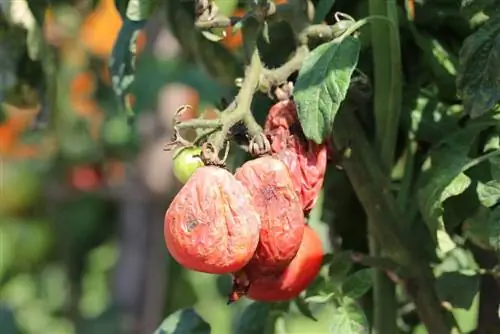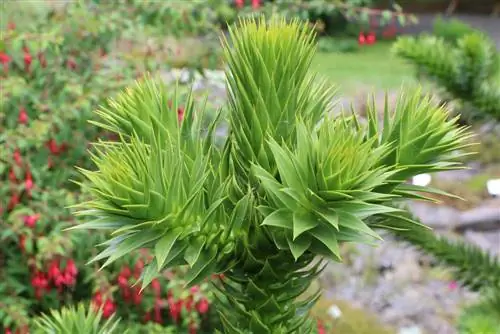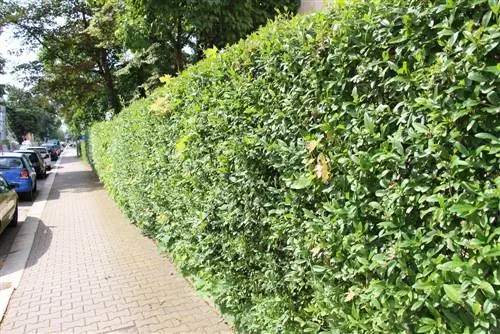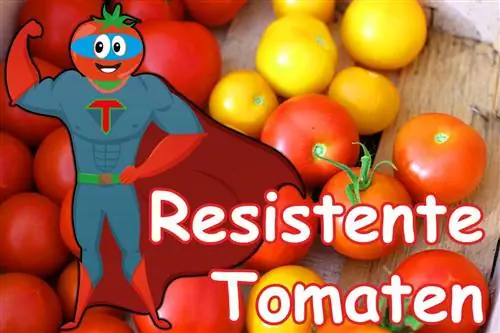- Author admin [email protected].
- Public 2023-12-17 03:39.
- Last modified 2025-01-24 12:45.
Tomatoes are sensitive plants where a variety of diseases and pests can spread. These primarily include bacteria, viruses and fungi, which can spread extremely quickly and threaten the entire harvest. Therefore, ideal location conditions and appropriate care are required for successful cultivation. When the first signs of damage appear, immediate countermeasures are necessary.
Disturbances in growth
Sheet Rolls
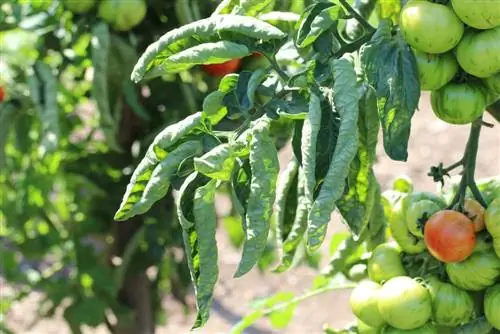
Leaf rolling is also called spoon leaf leafing because this disorder causes the leaves of the tomato plant to curl from bottom to top. In the initial stage the leaves look like little spoons.
- The cause is often too high a nutrient content
- Especially too much nitrate in the soil
- Alternatively, dryness is one of the causes
- Use organic fertilizers that work slowly
- Keep plants permanently and evenly moist
Blossom end rot
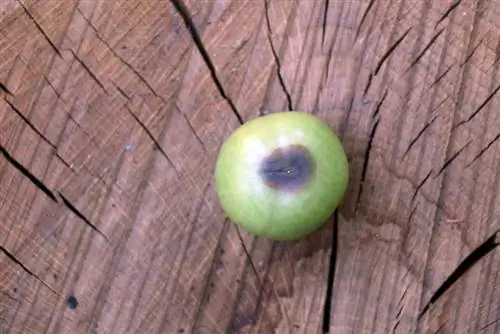
Blossom end rot is a calcium deficiency that causes the young leaves of the tomato plant to develop dark green deformities. As the disorder progresses, the older leaves also develop spots. The roots of the fruits show spots of a watery nature, then the tomatoes turn dark and harden completely.
- Causes are fertilizers that contain too much s alt
- Infrequent watering is also responsible for this
- If there is too little water, the absorption of calcium is difficult
- Administer lime carefully as an acute measure
- Ensure regular and sufficient water supply
- Use only balanced and gentle fertilizers
Green collar
The green collar is also known as the yellow collar because as the tomatoes ripen, a yellow to greenish collar-shaped ring forms around the base of the stem. The flesh then remains hard and never ripens. If only the fruits that are particularly exposed to the sun are affected, then it is an external influence. But if all fruits are affected by green collar, then the conditions in the soil are responsible.
- The cause is often too strong sunlight
- Build shading in summer
- Protect specifically from extreme midday heat
- For full sun locations, make sure you choose the right variety
- Light fruit types are ideal, for example cherry tomatoes
- Too much nitrogen and too little potassium in the soil can also be reasons
Damage caused by cold weather
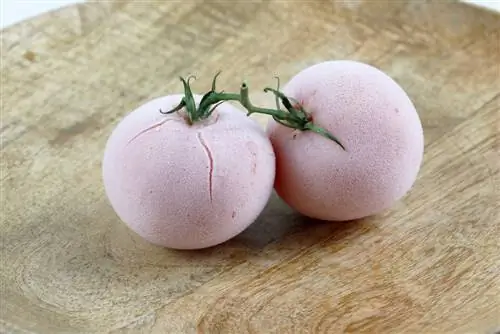
Cold damage can be recognized by noticeable brightening between the leaf veins. The tissue then dies in these places; in gardening jargon, this process is referred to as necrotization. In the event of extremely severe frostbite, the leaves turn brown, then dry up and die completely.
- Causes are temperatures that are too low
- Young and tender plants are particularly at risk
- Don’t put out young plants too early
- Temperature values below 6° C at night are harmful
- Always observe weather conditions and changes
- Protect with foil on cool nights
Lack of magnesium
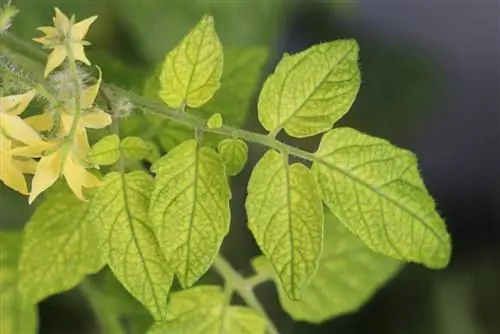
If there is a magnesium deficiency, it will first be noticed on the leaves. First, the leaf areas between the intense green main veins turn yellow, then they turn brown and die completely. The causes include similar reasons to calcium deficiency, which minimize the plant's absorption of magnesium.
- Too high nitrogen and potassium doses are responsible
- Extremely sandy and depleted soils are often to blame for this
- Also caused by too acidic pH value in the soil
- Conduct a soil test and determine the current pH value
- If the soil is too acidic, help with lime
- Additional fertilizers containing magnesium
- Ideal for balanced pH value is Epsom s alt
Sunburn
Tomatoes are heat and sun loving plants, but they can get sunburnt if exposed to too much sunlight. This can be recognized by light yellow and beige spots on the sunny side of the fruit.
- Protect from too bright sun
- Never remove too many leaves at once
- Leave enough shady leaves on the bush
- Build shade in summer, especially during midday heat
Water damage
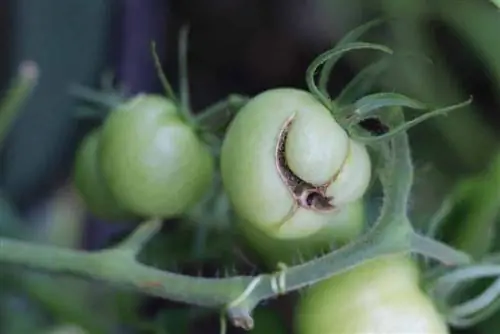
If the tomato fruits split open for no apparent reason, then it is usually due to water damage. This can usually be prevented with proper care and protective measures.
- Extremely heavy and sudden rain showers are often responsible
- Caused by excessive watering after long dry periods
- Always pay attention to balanced watering
- Provide protection during downpours and long periods of rain
- Build a covering shelter
Diseases caused by fungi
drought spot disease
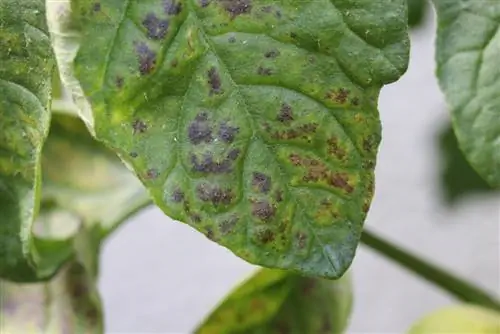
The dry spot disease is known in botany as Alternaria solani and first spreads on the lower leaves of tomato plants. These form brown spots with a ring-shaped demarcation. The fungus then gradually moves to the upper leaves and attacks the stems there. As the fruit progresses, it begins to rot at the base. Often the fungal spores are blown over from potato plants growing nearby. If this fungal attack occurs, countermeasures for the current growing season will be too late and the crop will fail.
- Infected soil, planters and sticks often pass on fungal spores
- Remove affected leaves immediately
- Ensure the environment is as dry as possible
- Clean and disinfect everything thoroughly
- Do not plant potatoes next to tomatoes
Powdery mildew
The powdery mildew has the botanical name Oidium neolycopersici and is noticeable through a white and mealy carpet of fungi on the leaves. After the first spots appear, the fungus spreads relatively quickly throughout the plant. The leaves turn brown, then wither and then die. However, the fruits are not affected by powdery mildew.
- Ideal conditions offer cool summers
- Mushroom prefers 20° C and high humidity
- There are no chemical control measures yet
- Timely detection is extremely important
- Destroy affected plant parts immediately
- Choose a tomato variety that is resistant to powdery mildew
Fruit and stem rot
Fruit and stem rot has the botanical name Didymella and is an insidious fungus that can spread extremely quickly via its spores. Didymella occurs predominantly on older tomato plants and can be identified by black discoloration that spreads from below on the stems. In this area the tissue has also sunk slightly. Damaged plants whose defenses are weakened are particularly susceptible to fruit and stem rot. The fruits appear intact from the outside due to the fungal infection, but they still have to be disposed of, otherwise they will spread further.
- Spreads quickly, especially in warm, humid weather
- Avoid damaged tissue at all costs
- Use caution when tying to avoid injury
- Also avoid extremely large wounds when thinning
- In the case of fungal infestation, only complete disposal helps
- Apply care thoroughly and carefully
- Sterilize used boxes, cords and rods
- Never use seeds from infected tomato plants
Grey mold/ghost spot (Botrytis cinerea)
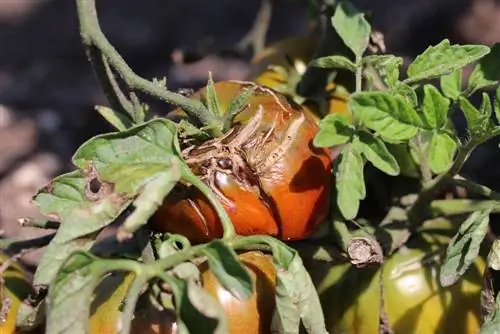
The gray mold is also colloquially called ghost spot disease and has the botanical name Botrytis cinerea. This mold initially appears on the leaves and stems as gray spots. This is followed by an extensive carpet of spores, which also spread to the fruits.
- Moisture provides ideal conditions
- Remove all affected parts immediately
- If stems are already infected, the entire plant often dies
Cork root disease
The cork root disease is known in botany as Pyrenochaeta lycopersici and often lurks in the soil. This fungus nests in old root parts that have already died. When infested, it also damages the roots of its host plant. The root tissue thickens and forms a cork-like tissue, hence the name.
- Is noticeable through slow growth
- Signals are also poor harvests and wilting appearance
- Tomato plants with weakly developed roots are extremely susceptible
- The ground is also very nutrient-poor soil
- Select grafted plants that are resistant to the fungus
Blight and brown rot
The late blight has the botanical name Phytophthora infestans and first appears on the fruits. These form brown and hard spots that have sunk significantly. Grey-green spots then appear on the lower rows of leaves. In the event of an extremely severe infestation, a gray carpet of fungus spreads on the underside of the leaves.
- Causes are often warm, humid weather
- Potato plants growing nearby are also responsible
- If the tomatoes are infected with fungus, they are no longer edible
- Keep plants dry in warm, humid weather
- Protect from rain by covering it
- Moving to a location with a roof shelter
Velvet spot disease
Velvet spot disease is also called Cladosporium fulvum in botany and first appears as pale yellow spots on the leaves. Then a brownish mold carpet spreads on the undersides of the leaves.
- Commonly found on tomato plants in greenhouses or under foil
- Don’t plant specimens too close together
- Avoid high humidity
- Select varieties resistant to velvet spot disease
Bacterial and viral diseases
If bacterial and virus-related diseases occur, then nothing can be done acutely about them. However, the risk of disease can be minimized in the long term by choosing varieties that are as resistant as possible. In addition, no large cuts should be made to the plant in order not to weaken it unnecessarily. Furthermore, it makes sense to combat pests in a timely manner, as they are among the vectors of bacteria and viruses.
- In case of infestation, dispose of affected plants, soil and accessories
- Ensure the long-term integrity of the tomato plants
- Do not damage the roots when inserting support rods
- Exercise extreme caution when loosening
- The virus infection thread foliage is widespread
- Bacterial wilt is also common
- Aphids in particular transmit diseases
Animal Pests
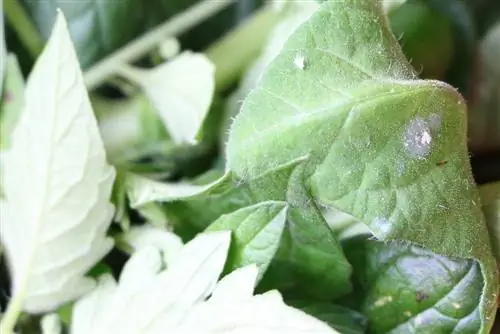
Spider mites
The spider mites have the botanical name Tetranychus urticae and spread particularly on tomatoes that grow in the greenhouse. These first appear on the leaves; the infestation can be recognized by the delicate spider threads on the leaf axils.
- Shower affected areas with a sharp jet of water
- Water must be able to drain quickly from leaves
- Otherwise the fungal spores will remain there
- Introduce predatory mites early to prevent the spread
Thrips
The thrips also goes by the name Fringed Wings and is listed in botany under Frankliniella occidentalis. The tiny little animals only grow up to 2 mm in size, and the infestation is shown by their small, black piles of excrement on the leaves. Small, white spots then form on the tomato fruits and leaves. New generations can form extremely quickly under ideal conditions.
- Prefers warm weather conditions
- They are difficult to detect at first
- Life hidden in the flowers
- Larvae pupate in the soil
- Set up blue glue boards to capture
- Use natural predators
- Lacewings and predatory mites curb the pest infestation
Tomato leafminer flies
The tomato leaf miner flies are known in botany as Liriomyza bryoniae and draw fine tunnels through the leaf tissue that have a curved shape. These tunnels are created by the voracious maggots of this reproductive fly.
- Remove pests immediately if infested
- Fight with biological means
- Parasitic wasps are natural predators
Tomato rust mites
The tomato rust mites have the botanical name Aculops lycopersici. Unfortunately, an infestation only becomes apparent when it is already too late to take countermeasures. If the shoots first turn brown, then the leaves turn yellow and then dry out, rust mites are often to blame.
- Infects the entire plant, from the stem to the young fruits
- Reproduce extremely quickly
- If infested, dispose of the entire plant immediately
- Use biological enemies in advance
Whitefly
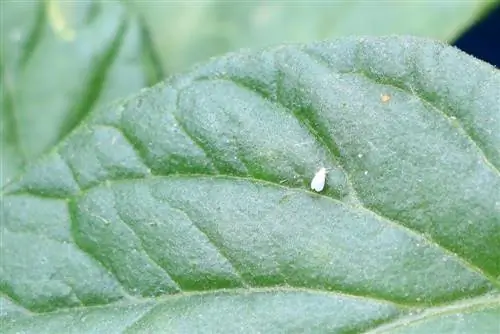
Whitefly is also called whitefly and in botany as Trialeurodes vaporariorum. This pest is predominantly active on tomato plants in the greenhouse. The infestation can be recognized by a sticky coating on the leaves. Whitefly insects are easy to recognize, they are about 2 mm large and white.
- Need 4 weeks for a development period
- Use parasitic wasps as a preventive measure

